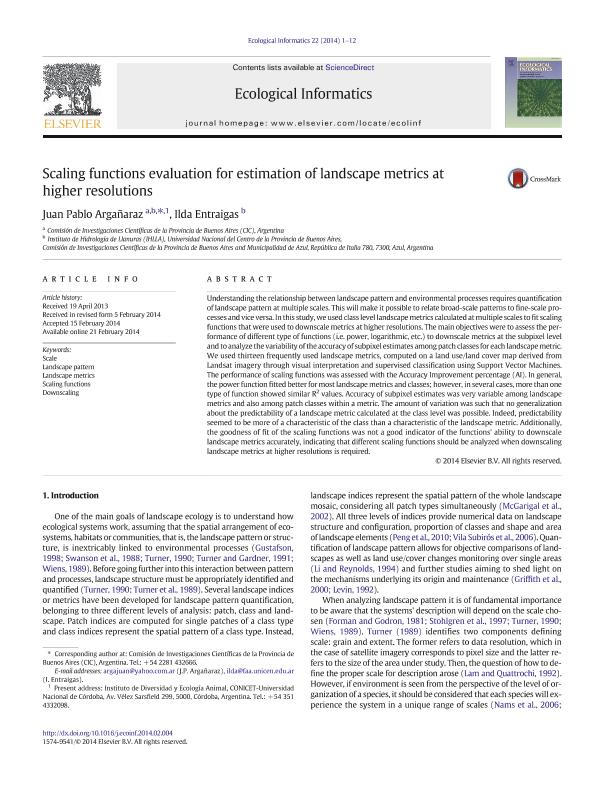Mostrar el registro sencillo del ítem
dc.contributor.author
Argañaraz, Juan Pablo

dc.contributor.author
Entraigas, Ilda
dc.date.available
2016-11-02T19:07:37Z
dc.date.issued
2014-07
dc.identifier.citation
Argañaraz, Juan Pablo; Entraigas, Ilda; Scaling functions evaluation for estimation of landscape metrics at higher resolutions; Elsevier Science; Ecological Informatics; 22; 7-2014; 1-12
dc.identifier.issn
1574-9541
dc.identifier.uri
http://hdl.handle.net/11336/7920
dc.description.abstract
Understanding the relationship between landscape pattern and environmental processes requires quantification of landscape pattern at multiple scales. This will make it possible to relate broad-scale patterns to fine-scale processes and vice versa. In this study, we used class level landscape metrics calculated at multiple scales to fit scaling functions that were used to downscale metrics at higher resolutions. The main objectives were to assess the performance of different type of functions (i.e. power, logarithmic, etc.) to downscale metrics at the subpixel level and to analyze the variability of the accuracy of subpixel estimates among patch classes for each landscape metric. We used thirteen frequently used landscape metrics, computed on a land use/land cover map derived from Landsat imagery through visual interpretation and supervised classification using Support Vector Machines. The performance of scaling functions was assessed with the Accuracy Improvement percentage (AI). In general, the power function fitted better for most landscape metrics and classes; however, in several cases, more than one type of function showed similar R2 values. Accuracy of subpixel estimates was very variable among landscape metrics and also among patch classes within a metric. The amount of variation was such that no generalization about the predictability of a landscape metric calculated at the class level was possible. Indeed, predictability seemed to be more of a characteristic of the class than a characteristic of the landscape metric. Additionally, the goodness of fit of the scaling functions was not a good indicator of the functions' ability to downscale landscape metrics accurately, indicating that different scaling functions should be analyzed when downscaling landscape metrics at higher resolutions is required.
dc.format
application/pdf
dc.language.iso
eng
dc.publisher
Elsevier Science

dc.rights
info:eu-repo/semantics/openAccess
dc.rights.uri
https://creativecommons.org/licenses/by-nc-nd/2.5/ar/
dc.subject
Scale
dc.subject
Landscape Pattern
dc.subject
Landscape Metrics
dc.subject
Scaling Functions
dc.subject
Downscaling
dc.subject.classification
Otras Ciencias Biológicas

dc.subject.classification
Ciencias Biológicas

dc.subject.classification
CIENCIAS NATURALES Y EXACTAS

dc.title
Scaling functions evaluation for estimation of landscape metrics at higher resolutions
dc.type
info:eu-repo/semantics/article
dc.type
info:ar-repo/semantics/artículo
dc.type
info:eu-repo/semantics/publishedVersion
dc.date.updated
2016-11-02T18:16:06Z
dc.journal.volume
22
dc.journal.pagination
1-12
dc.journal.pais
Países Bajos

dc.journal.ciudad
Amsterdam
dc.description.fil
Fil: Argañaraz, Juan Pablo. Provincia de Buenos Aires. Gobernación. Comisión de Investigaciones Científicas; Argentina. Universidad Nacional del Centro de la Provincia de Buenos Aires. Rectorado. Instituto de Hidrología de Llanuras - Sede Azul; Argentina. Consejo Nacional de Investigaciones Cientificas y Tecnicas. Centro Cientifico Tecnologico Cordoba. Instituto de Diversidad y Ecologia Animal; Argentina
dc.description.fil
Fil: Entraigas, Ilda. Universidad Nacional del Centro de la Provincia de Buenos Aires. Rectorado. Instituto de Hidrología de Llanuras - Sede Azul; Argentina
dc.journal.title
Ecological Informatics

dc.relation.alternativeid
info:eu-repo/semantics/altIdentifier/doi/http://dx.doi.org/10.1016/j.ecoinf.2014.02.004
dc.relation.alternativeid
info:eu-repo/semantics/altIdentifier/url/http://www.sciencedirect.com/science/article/pii/S1574954114000211
Archivos asociados
